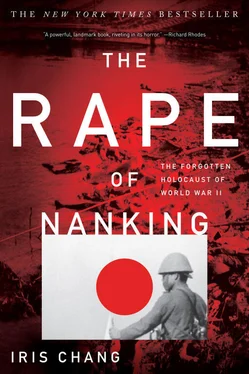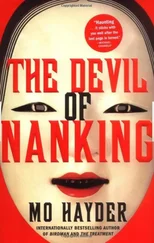Japanese schools operated like miniature military units. Indeed, some of the teachers were military officers, who lectured students on their duty to help Japan fulfill its divine destiny of conquering Asia and being able to stand up to the world’s nations as a people second to none. They taught young boys how to handle wooden models of guns, and older boys how to handle real ones. Textbooks became vehicles for military propaganda; one geography book even used the shape of Japan as justification for expansion: “We appear to be standing in the vanguard of Asia, advancing bravely into the Pacific. At the same time we appear ready to defend the Asian continent from outside attack.” Teachers also instilled in boys hatred and contempt for the Chinese people, preparing them psychologically for a future invasion of the Chinese mainland. One historian tells the story of a squeamish Japanese schoolboy in the 1930s who burst into tears when told to dissect a frog. His teacher slammed his knuckles against the boy’s head and yelled, “Why are you crying about one lousy frog? When you grow up you’ll have to kill one hundred, two hundred chinks!”
(And yet with all this psychological programming the story is much more complicated. “There was a deep ambivalence in Japanese society about China,” Oxford historian Rana Mitter observes. “It was not all racist contempt, as it was for the Koreans: on the one hand, they recognized China as a source of culture that they had drawn on heavily; on the other, they were exasperated by the mess that China was in by the early twentieth century. Ishiwara Kanji, architect of the Manchurian Incident of 1931, was a big fan of the 1911 Revolution. Many Chinese, including Sun Yatsen and Yuan Shikai, drew on Japanese help and training in the years before and after the 1911 Revolution. The Japanese also sponsored Boxer Indemnity Scholarships and Dojinkai hospitals for the Chinese, and scholars like Tokio Hashimoto genuinely appreciated Chinese culture. Japan’s Foreign Office and army experts on China were often very well trained and knowledgable about the country.” This knowledge and tempering, however, would rarely pass down to the ordinary soldier.)
The historical roots of militarism in Japanese schools stretched back to the Meiji Restoration. In the late nineteenth century the Japanese minister of education declared that schools were run not for the benefit of the students but for the good of the country. Elementary school teachers were trained like military recruits, with student-teachers housed in barracks and subjected to harsh discipline and indoctrination. In 1890 the Imperial Rescript on Education emerged; it laid down a code of ethics to govern not only students and teachers but every Japanese citizen. The Rescript was the civilian equivalent of Japanese military codes, which valued above all obedience to authority and unconditional loyalty to the emperor. In every Japanese school a copy of the Rescript was enshrined with a portrait of the emperor and taken out each morning to be read. It was reputed that more than one teacher who accidentally stumbled over the words committed suicide to atone for the insult to the sacred document.
By the 1930s the Japanese educational system had become regimented and robotic. A visitor to one of its elementary schools expressed pleasant surprise at seeing thousands of children waving flags and marching in unison in perfect lines; quite clearly the visitor had seen the discipline and order but not the abuse required to establish and maintain it. It was commonplace for teachers to behave like sadistic drill sergeants, slapping children across the cheeks, hitting them with their fists, or bludgeoning them with bamboo or wooden swords. Students were forced to hold heavy objects, sit on their knees, stand barefoot in the snow, or run around the playground until they collapsed from exhaustion. There were certainly few visits to the schools by indignant or even concerned parents.
The pressure to conform to authority intensified if the schoolboy decided to become a soldier. Vicious hazing and a relentless pecking order usually squelched any residual spirit of individualism in him. Obedience was touted as a supreme virtue, and a sense of individual self-worth was replaced by a sense of value as a small cog in the larger scheme of things. To establish this sublimation of individuality to the common good, superior officers or older soldiers slapped recruits for almost no reason at all or beat them severely with heavy wooden rods. According to the author Iritani Toshio, officers often justified unauthorized punishment by saying, “I do not beat you because I hate you. I beat you because I care for you. Do you think I perform these acts with hands swollen and bloody in a state of madness?” Some youths died under such brutal physical conditions; others committed suicide; the majority became tempered vessels into which the military could pour a new set of life goals.
Training was no less grueling a process for aspiring officers. In the 1920s all army cadets had to pass through the Military Academy at Ichigaya. With its overcrowded barracks, unheated study rooms, and inadequate food, the place bore a greater resemblance to a prison than a school. The intensity of the training in Japan surpassed that of most Western military academies: in England an officer was commissioned after some 1,372 hours of classwork and 245 hours of private study, but in Japan the standards were 3,382 hours of classwork and 2,765 hours of private study. The cadets endured a punishing daily regimen of physical exercise and classes in history, geography, foreign languages, mathematics, science, logic, drawing, and penmanship. Everything in the curriculum was bent toward the goal of perfection and triumph. Above all the Japanese cadets were to adopt “a will which knows no defeat.” So terrified were the cadets of any hint of failure that examination results were kept secret, to minimize the risk of suicide.
The academy was like an island to itself, sealed off from the rest of the world. The Japanese cadet enjoyed neither privacy nor any opportunity to exercise individual leadership skills. His reading material was carefully censored, and leisure time was nonexistent. History and science were distorted to project an image of the Japanese as a superrace. “During these impressionable years they have been walled off from all outside pleasures, interests or influences,” one Western writer observed of the Japanese officers. “The atmosphere of the narrow groove along which they have moved has been saturated with a special national and a special military propaganda. Already from a race psychologically far removed from us, they have been removed still further.”
In the summer of 1937 Japan finally succeeded in provoking a full-scale war with China. In July a Japanese regiment, garrisoned by treaty in the Chinese city of Tientsin, had been conducting night maneuvers near the ancient Marco Polo Bridge. During a break several shots were fired at the Japanese in the darkness, and a Japanese soldier failed to appear during roll call. Using this incident as an excuse to exercise Japan’s power in the region, Japanese troops advanced upon the Chinese fort of Wanping near the bridge and demanded that its gates be opened so that they could search for the soldier. When the Chinese commander refused, the Japanese shelled the fort.
By the end of July, Japan had tightened its grasp on the entire Tientsin-Peking region and by August the Japanese had invaded Shanghai. The second Sino-Japanese War was no longer reversible.
But conquering China proved to be a more difficult task than the Japanese anticipated. In Shanghai alone Chinese forces outnumbered the Japanese marines ten to one, and Chiang Kai-shek, leader of the Nationalist government, had reserved his best troops for the battle. That August, while attempting to land thirty-five thousand fresh troops on the docks of Shanghai, the Japanese encountered their first setback. A hidden Chinese artillery emplacement opened fire and killed several hundred men, including a cousin of the Empress Nagako. For months the Chinese defended the metropolis with extraordinary valor. To the chagrin of the Japanese, the battle of Shanghai proceeded slowly, street by street, barricade by barricade.
Читать дальше











